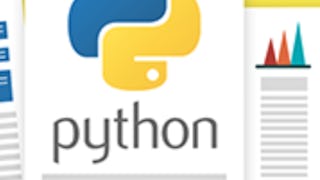This course provides an introduction to basic data science techniques using Python. Students are introduced to core concepts like Data Frames and joining data, and learn how to use data analysis libraries like pandas, numpy, and matplotlib. This course provides an overview of loading, inspecting, and querying real-world data, and how to answer basic questions about that data. Students will gain skills in data aggregation and summarization, as well as basic data visualization.



Data Analysis Using Python
This course is part of Introduction to Programming with Python and Java Specialization

Instructor: Brandon Krakowsky
30,908 already enrolled
Included with 
(416 reviews)
Recommended experience
What you'll learn
Apply basic data science techniques using Python
Understand and apply core concepts like Data Frames and joining data, and use data analysis libraries like pandas, numpy, and matplotlib
Demonstrate how to load, inspect, and query real-world data, and answer basic questions about that data
Analyze data further by applying learned skills in data aggregation and summarization, as well as basic data visualization
Skills you'll gain
Details to know

Add to your LinkedIn profile
7 assignments
See how employees at top companies are mastering in-demand skills

Build your subject-matter expertise
- Learn new concepts from industry experts
- Gain a foundational understanding of a subject or tool
- Develop job-relevant skills with hands-on projects
- Earn a shareable career certificate


Earn a career certificate
Add this credential to your LinkedIn profile, resume, or CV
Share it on social media and in your performance review

There are 3 modules in this course
This first module provides students with an overview of loading, inspecting, and exploring data using Python's simple csv library. To get started, this module includes a brief overview of Jupyter Notebook and a concise review of basic Python, including data structures, loops, and functions. This module showcases to the students an in-depth analysis of data stored in a .csv file, including basic querying, approaches for dealing with data errors, and how to filter and sort data based on a variety of criteria.
What's included
8 videos10 readings3 assignments1 programming assignment
In this module, students are introduced to core concepts like the Data Frame and joining data. Students will get experience using pandas, an industry-standard data analysis library, to load and query real-world data and to answer questions about that data. This module demonstrates how to do advanced filtering and indexing, slice subsets of data, restrict data attributes in query results, and do basic computations over the data. Includes how to build a simple recommendation system, and approaches for cleaning data, dealing with missing values, and creating new data.
What's included
14 videos5 readings2 assignments2 programming assignments
This module takes data analysis a step further by providing an overview of the process of aggregating, summarizing, and visualizing data. Students are introduced to the concept of grouping and indexing data, and how to display results in a pivot table using pandas. This module also demonstrates how to prepare and visualize data using a histogram and scatterplot in Jupyter Notebook. Students will gain skills in data aggregation and summarization, as well as basic data visualization. In addition, students will get experience using data analysis libraries like numpy and matplotlib.
What's included
18 videos6 readings2 assignments2 programming assignments
Instructor

Offered by
Recommended if you're interested in Data Analysis


Simplilearn


University of Michigan
Why people choose Coursera for their career




Learner reviews
416 reviews
- 5 stars
68.75%
- 4 stars
22.11%
- 3 stars
4.80%
- 2 stars
1.44%
- 1 star
2.88%
Showing 3 of 416
Reviewed on Jan 14, 2022
This is a good course! I hope University of Pennsylvania will offer the more advanced course so I can enroll, too! Kudos to the instruction and to the staff.
Reviewed on Feb 7, 2021
Videos touching same theme were too short (26 sec, 1 min, etc.) and disruptive. Wish there could be more practices.
Reviewed on Apr 12, 2021
Excellent course. Assignments /home work explaination need to be rethought. Special thanks to Jahnavi for helping through out the course.
New to Data Analysis? Start here.

Open new doors with Coursera Plus
Unlimited access to 10,000+ world-class courses, hands-on projects, and job-ready certificate programs - all included in your subscription
Advance your career with an online degree
Earn a degree from world-class universities - 100% online
Join over 3,400 global companies that choose Coursera for Business
Upskill your employees to excel in the digital economy
Frequently asked questions
The only math that learners will need for this Specialization is arithmetic and basic concepts in logic.
If you enjoyed this course, we recommend Courses 1, 3 and 4 in the series!
If you would like to learn the fundamentals of computer science beyond the basics of programming, consider applying to the Master of Computer and Information and Technology (MCIT) at the University of Pennsylvania, an Ivy League computer science master’s program for people without a computer science background. For an on-campus experience, explore here. If you prefer an online setting, apply to MCIT Online. In fact, the lectures in this series are also used in the online degree program! The Specialization certificate will be viewed favorably by the admissions committee, so be sure to mention it when you apply.
Access to lectures and assignments depends on your type of enrollment. If you take a course in audit mode, you will be able to see most course materials for free. To access graded assignments and to earn a Certificate, you will need to purchase the Certificate experience, during or after your audit. If you don't see the audit option:
The course may not offer an audit option. You can try a Free Trial instead, or apply for Financial Aid.
The course may offer 'Full Course, No Certificate' instead. This option lets you see all course materials, submit required assessments, and get a final grade. This also means that you will not be able to purchase a Certificate experience.
More questions
Financial aid available,





